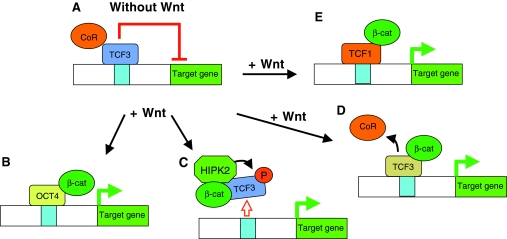Fig. 4.
Models for how Wnt signaling maintains pluripotency in ES cells. (A) In the absence of Wnt signaling, β-catenin (βcat) is degraded, and TCF3 in complex with transcriptional co-repressors (CoR) constitutively represses Wnt target genes. (B-E) Upon Wnt pathway activation, several alternative models leading to pluripotency are possible: (B) stabilized β-catenin associates with OCT4 to activate OCT4-dependent transcription; (C) HIPK2 is activated by Wnt signaling, associates with β-catenin and phosphorylates TCF3; this phosphorylation results in the removal of TCF3 from target promoters, leading to transcriptional derepression; (D) stabilized β-catenin associates with TCF3, causing the removal of the co-repressors resulting in target derepression (this model predicts that TCF3 is still bound to the promoter but no longer represses its gene targets); and (E) the TCF switch model, in which TCF3 repressor is replaced by TCF1 activator, leading to target activation and pluripotency. OCT4, octamer-binding transcription factor 4.

